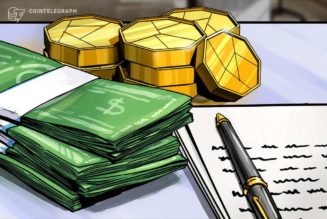
“That’s when this stuff gets really ugly, and you start to see the top end of the sanctions the U.S. is going to impose,” said Brian O’Toole, a former senior adviser at the Treasury Department’s Office of Foreign Assets Control, of the possibility that Russia might attack the Ukrainian capital. “That could spike prices.”
It could also shred the forecasts of Fed Chair Jerome Powell and other policymakers — and the hopes of the Biden White House — that price increases might begin to cool naturally as Fed and congressional aid to the economy fades and the supply chain bottlenecks ease.
Financial markets have been jittery as investors try to make sense of the economic outlook as geopolitical tensions ratchet up; on Wednesday, the Dow Jones Industrial Average closed at its lowest level in 2022. The potential implications for the U.S. economy extend beyond energy — the threat of cyberattacks could further deepen global production and shipping delays, and Russia is also a major exporter of other commodities and metals like steel. But sales of oil and natural gas make up roughly 40 percent of Russia’s revenue, meaning any conflict would inflict pain both on Moscow and the rest of the world.
It is higher energy costs that present the biggest risk of further boosting U.S. inflation from its four-decade high — both directly for Americans at the gas pump and indirectly as travel and transportation of goods becomes more expensive.
American consumer confidence has already been sliding, dropping 8.2 percent from January to February, according to a University of Michigan survey.
President Joe Biden on Tuesday acknowledged the possibility that Americans would have to sacrifice if the situation deteriorates in Ukraine.
“My administration is using every tool at our disposal to protect American businesses and consumers from rising prices at the pump,” the president said. “Defending freedom will have costs for us as well, here at home. We need to be honest about that.”
He said the U.S. is “executing a plan in coordination with major oil-producing consumers and producers toward a collective investment to secure stability and global energy supplies,” adding, “this will blunt gas prices.”
White House press secretary Jen Psaki also said the administration is considering releasing more oil from federal emergency reserves. Her announcement late Wednesday caused the benchmark U.S. oil price to give back much of its gains on the day and close at around $93 a barrel. But prices again surged after Russia began a widescale attack on Ukraine, with global benchmark Brent breaching $100 a barrel.
The question is how high global oil prices will go, with the answer partially dependent on how the U.S. and Europe will respond. Directly sanctioning Russian energy companies might be on the table, which would reverberate throughout the world.
For the U.S., higher gas prices would further squeeze consumers’ wallets, although healthy wage growth might mean that enough Americans can afford those prices to keep costs high. A worse possibility for the Fed is that rising energy costs could spur workers to push for higher pay for reasons unconnected to the growth and productivity of the economy — boosting inflation even more.
Diane Swonk, chief economist at Grant Thornton, estimates that a sustained period of $125-a-barrel oil would stall growth and lead to rising unemployment. The economy could better weather six months of averaging around $100, closer to where prices stand now, but that would also worsen the inflation problem, she said.
“It couldn’t come at a worse time for the Federal Reserve, because there’s something eerily reminiscent of the oil shock back in 1973, where we’ve already got well-kindled inflation,” she said.
The Fed might have to steadily raise interest rates to avoid the combination of stagnant growth and inflation that was dubbed “stagflation” back in the 1970s, when prices rose as much as 14 percent even as the economy saw unemployment climb. The central bank didn’t fully tame that inflation until years later, when it cranked interest rates up to nearly 20 percent, leading to multiple recessions.
“Unless you have a full meltdown in financial markets, you’ve got to keep” hiking rates, Swonk said. “The risk that you’re boosting inflation that’s already at risk of becoming more entrenched, that’s not a place you want to let inflation go. That’s the ’70s, and the ’70s is what haunts the Fed the most.”
There could be at least one pocket of hope on the horizon.
Experts pointed to indications that the Biden administration is making headway on a nuclear agreement with Iran, which could end sanctions on that country’s oil exports and fill some of the supply shortfall.
Iran probably has about 1.4 million barrels per day available to enter the global market if a nuclear deal can be reached, according to research firm ClearView, and a full ramp-up could coincide with the summer driving season, when gas prices typically rise in the U.S.
Still, Al Salazar, vice president of intelligence at energy analytics firm Enverus, said the Organization of the Petroleum Exporting Countries doesn’t have much spare capacity to ramp up production to offset any restraint on Russian oil exports. The U.S. itself might increase output, but that could lead to the opposite problem later this year, when the need is less.
“Biden finds himself in a very difficult position here,” Salazar said. “He’s trying to react in the middle of an already inflationary environment, and anything he does in terms of oil will make that worse.”
Josh Siegel contributed to this report.
[flexi-common-toolbar] [flexi-form class=”flexi_form_style” title=”Submit to Flexi” name=”my_form” ajax=”true”][flexi-form-tag type=”post_title” class=”fl-input” title=”Title” value=”” required=”true”][flexi-form-tag type=”category” title=”Select category”][flexi-form-tag type=”tag” title=”Insert tag”][flexi-form-tag type=”article” class=”fl-textarea” title=”Description” ][flexi-form-tag type=”file” title=”Select file” required=”true”][flexi-form-tag type=”submit” name=”submit” value=”Submit Now”] [/flexi-form]









